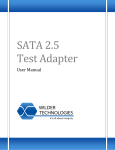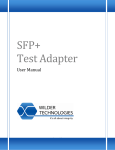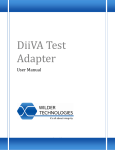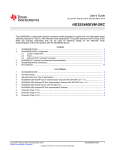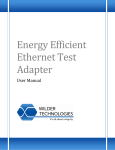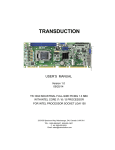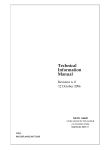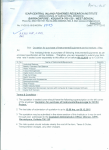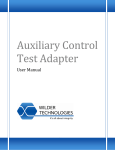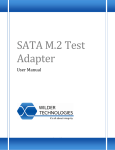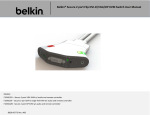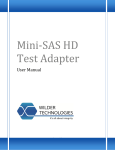Download USB 3.1 Type‐C Power Delivery Coupon
Transcript
USB 3.1 TypeC Power Delivery Coupon User Manual (Preliminary) USB 3.1 Type‐C Power Delivery Coupon User Manual (Preliminary) P a g e | 1 ©2015 Wilder Technologies, LLC Document No. 910‐0041‐200 Rev. A (Preliminary) USB 3.1 TypeC Power Delivery Coupon User Manual (Preliminary) Table of Contents Introduction ..................................................................................................................................... 3 Product Inspection .......................................................................................................................... 5 The USB 3.1 Type‐C Power Delivery Coupon Care and Handling Precautions ................................ 6 General Test Coupon, Optional Cables, and Connectors ................................................................ 7 Handling and Storage .................................................................................................................. 7 Visual Inspection.......................................................................................................................... 7 Cleaning ....................................................................................................................................... 7 Making Connections .................................................................................................................... 7 Electrostatic Discharge Information ................................................................................................ 8 Mechanical and Environmental Specifications................................................................................ 9 Electrical Specifications ................................................................................................................. 11 USB 3.1 Power Delivery Coupon User Model ................................................................................ 12 USB 3.1 Power Delivery Coupon Reference Information .............................................................. 13 Wilder Technologies, LLC – Limited Warranty .............................................................................. 15 Wilder Technologies, LLC – Terms & Conditions of Sale ............................................................... 16 Compliance with Environmental Legislation ................................................................................. 17 WEEE Compliance Statement .................................................................................................... 17 Glossary of Terms (USB 3.1) .......................................................................................................... 18 Glossary of Terms (DisplayPort) .................................................................................................... 21 Index .............................................................................................................................................. 22 P a g e | 2 ©2015 Wilder Technologies, LLC Document No. 910‐0041‐200 Rev. A (Preliminary) USB 3.1 TypeC Power Delivery Coupon User Manual (Preliminary) Introduction This user’s guide documents the USB 3.1 Type‐C Power Delivery Coupon (USB3.1‐C‐PDC) as used with USB 3.1 Type‐C, DisplayPort Type‐C, and Thunderbolt Type‐C products. The USB3.1‐
C‐PDC (here forward described as “PDC”), when used with the appropriate test hardware and instrumentation, can be used for several Power Delivery and related tests, including the following:
USB‐PD eMark Cable Testing CC Electrical & Protocol Decode Testing Power Provider Stress Testing Source and Sink Testing Figure 1. The USB 3.1 Type-C-Power Delivery Coupon (USB3.1-C-PDC).
Figure 2. USB3.1-C-PDC Transmit and Receive Connections (all connections pass straight through).
P a g e | 3 ©2015 Wilder Technologies, LLC Document No. 910‐0041‐200 Rev. A (Preliminary) USB 3.1 TypeC Power Delivery Coupon User Manual (Preliminary) To support Power Provider Stress Testing, and/or Source and Sink Testing, the following cables may be ordered separately as an option. 1.
Cable Assembly, Isolated US/DS, Power Delivery Coupon, USB 3.1 Type‐C (Wilder P/N 415‐0071‐000). 2.
Cable Assembly, Connected US/DS, Power Delivery Coupon, USB 3.1 Type‐C (Wilder P/N 415‐0072‐000). Figure 3. PDC Optional Cables – Isolated Upstream/Downstream (Top), Connected
Upstream/Downstream (Bottom).
P a g e | 4 ©2015 Wilder Technologies, LLC Document No. 910‐0041‐200 Rev. A (Preliminary) USB 3.1 TypeC Power Delivery Coupon User Manual (Preliminary) Product Inspection Upon receiving the PDC from Wilder Technologies, perform the following product inspection:
Inspect the outer shipping container, foam‐lined instrument case, and product for damage. Retain the outer cardboard shipping container until the contents of the shipment have been inspected for completeness and the product has been checked mechanically and electrically. Use the foam‐lined instrument‐case for secure storage of the Wilder Technologies PDC when not in use. Locate the shipping list and verify that all items ordered were received. In the unlikely event that the product is defective or incomplete, the “Limited Warranty” section discusses how to contact Wilder Technologies for technical assistance and/or how to package the product for return. P a g e | 5 ©2015 Wilder Technologies, LLC Document No. 910‐0041‐200 Rev. A (Preliminary) USB 3.1 TypeC Power Delivery Coupon User Manual (Preliminary) The USB 3.1 Type‐C Power Delivery Coupon Care and Handling Precautions When using the PDC with cables and/or test hardware and instrumentation, careful handling is required to avoid damage. Improper handling techniques can damage the Type‐C interface connectors or probe/signal access points present on the PDC. To achieve optimum performance and to prolong the PDC and test hardware/instrument life, observe the following handling precautions:
CAUTION 1: Avoid Torque Forces (Twisting) Ensure that any attached cables or attached test probes are free from applying twisting or torque forces to the PDC. Adherence to Caution 5 (below) helps to avoid exceeding twist limits. CAUTION 2: Avoid Sharp Cable Bends Test equipment cables, especially test instrument coaxial cables, should never be bent into a radius of 26 mm (1‐inch) or less. Never bend instrument cables greater than 90°. Single or multiple cable bends should always be kept within this limit. CAUTION 3: Avoid Multilateral Tension (Multiple Side Forces) To avoid applying multilateral tension to the PDC, always place accessories and equipment on a surface that allows adjustment to eliminate tension on the PDC and attached cables. Use adjustable elevation stands or apparatus to accurately place and support the PDC. CAUTION 4: Carefully Make Connections Prior to making connections, inspect the PDC Type‐C Plug and Receptacle connectors for debris, contamination, or misaligned contacts. Do the same with any mating cable or other test hardware. If missing or misaligned contacts are found anywhere along the test setup, do not use the component exhibiting the problem. Following inspection, carefully align the Type‐C connectors and then gently push the connectors together until fully seated. CAUTION 5: Independently Support Instrument Cables or Accessories Excessive weight from instrument cables and/or accessories connected to the PDC can cause damage or affect test accuracy. Be sure to provide appropriate means to support and stabilize all test set‐up components. P a g e | 6 ©2015 Wilder Technologies, LLC Document No. 910‐0041‐200 Rev. A (Preliminary) USB 3.1 TypeC Power Delivery Coupon User Manual (Preliminary) General Test Coupon, Optional Cables, and Connectors Observing simple precautions can ensure accurate and reliable measurements. Handling and Storage Before each use of the PDC, ensure that all connectors are clean. Handle the optional cables carefully and store the PDC in the foam‐lined instrument case when not in use, if possible. Do not set connectors contact end down. Visual Inspection Be sure to inspect all optional cable connectors carefully before making a connection. Inspect the optional cables for metal particles, deformed housings, dents, or bent, broken, or misaligned connector contacts. Do not use damaged cables. Cleaning If necessary, clean connectors using low‐pressure (less than 60 PSI) compressed air or nitrogen with an effective oil‐vapor filter and condensation trap. If further cleaning is necessary, clean connectors using a lint‐free swab or cleaning cloth moistened with isopropyl alcohol. Always completely dry a connector before use. Do not use abrasives to clean the connectors. Re‐inspect connectors, making sure no particles or residue remains. Making Connections Before making any connections, review the “Care and Handling Precautions” section. Follow these guidelines when making connections:
Align cables carefully Make preliminary connections lightly To tighten instrument SMA connections, turn the connector nut only Do not apply bending force to the instrument coaxial cables Do not over‐tighten preliminary instrument connections Do not twist or screw‐in instrument cables For instrument SMA connections, use a torque wrench, and do not tighten past the “break” point of the torque wrench P a g e | 7 ©2015 Wilder Technologies, LLC Document No. 910‐0041‐200 Rev. A (Preliminary) USB 3.1 TypeC Power Delivery Coupon User Manual (Preliminary) Electrostatic Discharge Information Protection against electrostatic discharge (ESD) is essential while connecting, inspecting, or cleaning the PDC and connectors when attached to a static‐sensitive circuit (such as those found in test sets). Electrostatic discharge can damage or destroy electronic components. Be sure to perform all work on electronic assemblies at a static‐safe work station, using two types of ESD protection:
Conductive table‐mat and wrist‐strap combination Conductive floor‐mat and heel‐strap combination When used together, both of these types provide a significant level of ESD protection. Used alone, the table‐mat and wrist‐strap combination provide adequate ESD protection. To ensure user safety, the static‐safe accessories must provide at least 1 MΩ of isolation from ground. Acceptable ESD accessories may be purchased from a local supplier. WARNING: These techniques for a static‐safe work station should not be used when working on circuitry with a voltage potential greater than 500 volts. P a g e | 8 ©2015 Wilder Technologies, LLC Document No. 910‐0041‐200 Rev. A (Preliminary) USB 3.1 TypeC Power Delivery Coupon User Manual (Preliminary) Mechanical and Environmental Specifications NOTE: All specifications in this manual are subject to change. Table 1. General Specifications
ITEM DESCRIPTION Usage Environment Controlled indoor environment PDC Length x Width x Height (Includes VBUS Current Probe Loop) 112.04 mm (4.411 in) x 12.7 mm (0.50 in) x 53.98 mm (2.125 in) Operating Temperature 0°C to +55°C (32°F to +131°F) (Characteristic) Storage Temperature ‐40°C to +70°C (‐40°F to +158°F) (Characteristic) SBU1 and SBU2 US/DS Jumpers USB 3.1 Type‐C Plug Connector Ground Test Points (4‐Each) VBUS Upstream Test Points
CC1 and CC2 US/DS Jumpers VBUS Downstream Test Points
VBUS US/DS Loop Cable (Not Shown for Clarity)
USB 3.1 Type‐C Receptacle Connector Probe Access Pins (0.025 square posts on 0.100 centers) 4 Sets Figure 4. Connectors and Jumpers (Power Delivery Coupon)
USB 3.1 Type‐C Power Delivery Coupon Pin‐out The PDC has a USB 3.1 Type‐C Plug Connector, a USB 3.1 Type‐C Receptacle Connector, Upstream to Downstream SBU and VBUS Jumpers, Probe pins for SBU and CC signal access, and test points for access to Ground and VBUS Upstream/Downstream. A short VBUS US/DS “Loop” cable assembly is also provided as a current probe “Tap”, or can attach to optional cable assemblies for Power Provider Stress Testing or Source and Sink Testing. P a g e | 9 ©2015 Wilder Technologies, LLC Document No. 910‐0041‐200 Rev. A (Preliminary) USB 3.1 TypeC Power Delivery Coupon User Manual (Preliminary) Table 2. Pin Assignments for the USB 3.1 Type-C Connectors
Pin Signal Name Pin Signal Name A1 GND Ground return B12 GND A2 SSTXp1 Positive half of first SuperSpeed TX differential pair B11 SSRXp1 Positive half of first SuperSpeed RX differential pair A3 SSTXn1 Negative half of first SuperSpeed TX differential pair B10 SSRXn1 Negative half of first SuperSpeed RX differential pair A4 VBUS Bus Power B9 VBUS Bus Power A5 CC1 Configuration Channel B8 SBU2 Sideband Use (SBU) A6 Dp1 Positive half of the USB 2.0 differential pair – Position 1 B7 Dn2 Negative half of the USB 2.0 differential pair – Position 2 A7 Dn1 Negative half of the USB 2.0 differential pair – Position 1 B6 Dp2 Positive half of the USB 2.0 differential pair – Position 2 A8 SBU1 Sideband Use (SBU) B5 CC2 Configuration Channel A9 VBUS Bus Power B4 VBUS A10 SSRXn2 Negative half of second SuperSpeed RX differential pair B3 SSTXn2 Negative half of second SuperSpeed TX differential pair A11 SSRXp2 Positive half of second SuperSpeed RX differential pair B2 SSTXp2 Positive half of second SuperSpeed TX differential pair A12 GND Ground return B1 GND Description Description Ground return Bus Power Ground return Table 3. Pin Assignments Graphic Table for the Type-C Connectors
A1 A2 A3 A4 A5 A6 A7 A8 A9 A10 A11 A12 GND TX1+ TX1‐ VBUS CC1 D1+ D1‐ SBU1 VBUS RX2‐ RX2+ GND GND RX1+ RX1‐ VBUS SBU2 D2‐ D2+ CC2 VBUS TX2‐ TX2+ GND B12 B11 B10 B9 B8 B7 B6 B5 B4 B3 B2 B1 Figure 5. USB3.1-C-PDC Transmit and Receive Connections (all connections pass straight through).
P a g e | 10 ©2015 Wilder Technologies, LLC Document No. 910‐0041‐200 Rev. A (Preliminary) USB 3.1 TypeC Power Delivery Coupon User Manual (Preliminary) Electrical Specifications NOTE: All specifications in this manual are subject to change. Table 4. USB 3.1 Type-C Power Delivery Coupon Electrical Specifications
SPECIFICATION MINIMUM TYPICAL MAXIMUM NOTES P a g e | 11 ©2015 Wilder Technologies, LLC Document No. 910‐0041‐200 Rev. A (Preliminary) USB 3.1 TypeC Power Delivery Coupon User Manual (Preliminary) USB 3.1 Power Delivery Coupon User Model The following illustration is an example of a Power Delivery test set‐up and usage. Refer to the product Compliance Test Specification (CTS) and/or the Test and Measurement Manufacturer’s Method of Implementation (MOI) for specific test set‐up details and equipment. Instrumentation shown in the following illustrations is for example only and may vary, depending on the Test and Measurement Manufacturer’s MOI. Equivalent accessories should be used. Figure 6. Example of eMark Cable Test Set-up
P a g e | 12 ©2015 Wilder Technologies, LLC Document No. 910‐0041‐200 Rev. A (Preliminary) USB 3.1 TypeC Power Delivery Coupon User Manual (Preliminary) USB 3.1 Power Delivery Coupon Reference Information This section contains an illustration of the PDC and the related schematic. USB 3.1 Type‐C Plug Connector (P1) Ground Test Points (4‐Each) SBU1 US/DS Jumper (JP6) and Probe Access Header (JP2) VBUS Downstream Test Points
VBUS Upstream Test Points
SBU2 US/DS Jumper (JP5) and Probe Access Header (JP1) VBUS US/DS Loop Cable (Not Shown for Clarity)
VCON and CC2 US/DS Jumper (JP7) and Probe Access Header (JP3) USB 3.1 Type‐C Receptacle Connector (J1)
CC and CC1 US/DS Jumper (JP8) and Probe Access Header (JP4) Figure 7. Connectors, Jumpers, Probe Access, and Test Points (Power Delivery Coupon)
P a g e | 13 ©2015 Wilder Technologies, LLC Document No. 910‐0041‐200 Rev. A (Preliminary) USB 3.1 TypeC Power Delivery Coupon User Manual (Preliminary) Figure 8. USB 3.1 Type-C Power Delivery Coupon Schematic P a g e | 14 ©2015 Wilder Technologies, LLC Document No. 910‐0041‐200 Rev. A (Preliminary) USB 3.1 TypeC Power Delivery Coupon User Manual (Preliminary) Wilder Technologies, LLC – Limited Warranty Wilder Technologies, LLC warrants that each Test Adapter, 1) is free from defects in materials and workmanship and, 2) conforms to Wilder Technologies specifications for a period of 12 months. See Consumable and Fragile Material Warranty for exceptions to the 12 month warranty The warranty period for a Test Adapter is a specified, fixed period commencing on the date of ship from Wilder Technologies, LLC. If you did not purchase your Test Adapter directly from Wilder Technologies, LLC, the serial number and a valid proof of purchase will be required to establish your purchase date. If you do not have a valid proof of purchase, the warranty period will be measured from the date of ship from Wilder Technologies, LLC. If, during the warranty period, the Test Adapter is not in good working order, Wilder Technologies, LLC will, at its option, repair or replace it at no additional charge, except as is set forth below. In some cases, the replacement Test Adapter may not be new and may have been previously installed. Regardless of the Test Adapter’s production status, Wilder Technologies, LLC appropriate warranty terms apply. Consumable and Fragile Material Warranty Wilder Technologies, LLC warrants that consumable materials and all fragile materials supplied by Wilder Technologies, LLC either as part of an instrument or system, or supplied separately, will be free from defects in material and workmanship at the time of shipment. Extent of Warranty The warranty does not cover the repair or exchange of a Test Adapter resulting from misuse, accident, modification, unsuitable physical or operating environment, improper maintenance by you, or failure caused by a product for which Wilder Technologies, LLC is not responsible. The warranty is voided by removal or alteration of Test Adapter or parts identification labels. The initial three months are unconditional; the remaining months excludes plugs, receptacles and SMA connectors. Connectors are wear items and excluded from the warranty after the initial three months. These warranties are your exclusive warranties and replace all other warranties or conditions, express or implied, including but not limited to, the implied warranties or conditions or merchantability and fitness for a particular purpose. These warranties give you specific legal rights and you may also have other rights which vary from jurisdiction to jurisdiction. Some jurisdictions do not allow the exclusion or limitation of express or implied warranties, so the above exclusion or limitation may not apply to you. In that event, such warranties are limited in duration to the warranty period. No warranties apply after that period. Items Not Covered by Warranty
Wilder Technologies, LLC does not warrant uninterrupted or error‐free operation of a Test Adapter. Any technical or other support provided for a Test Adapter under warranty, such as assistance via telephone with "how‐to" questions and those regarding Test Adapter set‐up and installation, will be provided WITHOUT WARRANTIES OF ANY KIND. Warranty Service Warranty service may be obtained from Wilder Technologies, LLC by returning a Wilder Technologies, LLC Returns Material Authorization and the Test Adapter to Wilder Technologies, LLC during the warranty period. To obtain RMA number, contact support@wilder‐tech.com. You may be required to present proof of purchase or other similar proof of warranty entitlement. You are responsible for any associated transportation charges, duties and insurance between you and Wilder Technologies, LLC. In all instances, you must ship Test Adapters in Wilder Technologies, LLC approved packaging. Information on packaging guidelines can be found at: www.wilder‐tech.com. Wilder Technologies, LLC will ship repaired or replacement Test Adapter Delivery Duty Prepaid (DDP) and will pay for return shipment. You will receive title to the repaired or replacement Test Adapter and you will be the importer of record. P a g e | 15 ©2015 Wilder Technologies, LLC Document No. 910‐0041‐200 Rev. A (Preliminary) USB 3.1 TypeC Power Delivery Coupon User Manual (Preliminary) Wilder Technologies, LLC – Terms & Conditions of Sale 1.
2.
3.
4.
5.
6.
Other Documents: This Agreement may NOT be altered, supplemented, or amended by the use of any other document(s) unless otherwise agreed to in a written agreement signed by both you and Wilder Technologies, LLC. If you do not receive an invoice or acknowledgement in the mail, via e‐mail, or with your Product, information about your purchase may be obtained at support@wilder‐tech.com or by contacting your sales representative. Payment Terms, Orders, Quotes, Interest: Terms of payment are within Wilder Technologies, LLC’s sole discretion, and unless otherwise agreed to by Wilder Technologies, LLC, payment must be received by Wilder Technologies, LLC prior to Wilder Technologies, LLC’s acceptance of an order. Payment for the products will be made by credit card, wire transfer, or some other prearranged payment method unless credit terms have been agreed to by Wilder Technologies, LLC. Invoices are due and payable within the time period noted on your invoice, measured from the date of the invoice. Wilder Technologies, LLC may invoice parts of an order separately. Your order is subject to cancellation by Wilder Technologies, LLC, in Wilder Technologies, LLC’s sole discretion. Unless you and Wilder Technologies, LLC have agreed to a different discount, Wilder Technologies, LLC’s standard pricing policy for Wilder Technologies, LLC‐branded systems, which includes hardware, software and services in one discounted price, allocates the discount off list price applicable to the service portion of the system to be equal to the overall calculated percentage discount off list price on the entire system. Wilder Technologies, LLC is not responsible for pricing, typographical, or other errors in any offer by Wilder Technologies, LLC and reserves the right to cancel any orders resulting from such errors. Shipping Charges; Taxes; Title; Risk of Loss: Shipping, handling, duties and tariffs are additional unless otherwise expressly indicated at the time of sale. Title to products passes from Wilder Technologies, LLC to Customer on shipment from Wilder Technologies, LLC’s facility. Loss or damage that occurs during shipping by a carrier selected by Wilder Technologies, LLC is Wilder Technologies, LLC’s responsibility. Loss or damage that occurs during shipping by a carrier selected by you is your responsibility. You must notify Wilder Technologies, LLC within 7 days of the date of your invoice or acknowledgement if you believe any part of your purchase is missing, wrong or damaged. Unless you provide Wilder Technologies, LLC with a valid and correct tax exemption certificate applicable to your purchase of Product and the Product ship‐to location, you are responsible for sales and other taxes associated with the order. Shipping dates are estimates only. WARRANTY: WILDER TECHNOLOGIES, LLC, warrants that the item(s) manufactured under the Buyer’s contract shall be free from defects in materials and workmanship furnished by WILDER TECHNOLOGIES, LLC, and shall conform to the applicable drawings and specifications. WILDER TECHNOLOGIES, LLC’S liability herein, for breach of warranty, contract or negligence in manufacturing, shall be limited to repair or replacement. Repair or replacement of defective items will be applicable only if the Buyer notifies WILDER TECHNOLOGIES, LLC, by written notice within 30‐days of delivery. All claims shall be addressed to: support@wilder‐tech.com or WILDER TECHNOLOGIES, LLC, 6101A East 18th Street, Vancouver, Washington 98661 U.S.A.; ATTENTION: Customer Service Manager. WILDER TECHNOLOGIES, LLC, reserves the right to inspect at the Buyer’s plant all items claimed to be defective or nonconforming prior to authorizing their return. WILDER TECHNOLOGIES, LLC, assumes no liability for the results of the use of its components in conjunction with other electric, electronic or mechanical components, circuits and/or systems. The foregoing constitutes the sole and exclusive remedy of the Buyer and the exclusive liability of WILDER TECHNOLOGIES, LLC, and is IN LIEU OF ANY AND ALL OTHER WARRANTIES, STATUTORY, IMPLIED OR EXPRESSED AS TO MERCHANTABILITY, FITNESS FOR THE PURPOSE SOLD, DESCRIPTION, QUALITY, and PRODUCTIVENESS OR ANY OTHER MATTER. Without limiting the foregoing, in no event shall WILDER TECHNOLOGIES, LLC, be liable for loss of use, profit or other collateral, or for special and/or consequential damages. RETURNED GOODS: WILDER TECHNOLOGIES, LLC, will accept only those goods for return that have been authorized for return. All goods authorized for return shall be assigned a Returned Material Authorization (RMA) Number. The RMA Number shall be clearly marked on the shipping container(s) and all documentation accompanying the goods authorized for return. The RMA Number shall be assigned by WILDER TECHNOLOGIES, LLC pursuant to the conditions set forth in Paragraph 4, WARRANTY. UNITED STATES GOVERNMENT CONTRACTS: In the event this offer is accepted under Government contract, WILDER TECHNOLOGIES, LLC, agrees to accept clauses required by Government regulations and to waive WILDER TECHNOLOGIES, LLC conditions inconsistent therewith. WILDER TECHNOLOGIES, LLC, certifies that it is a regular manufacturer or dealer of the goods and/or services offered herein and that the prices offered do not exceed those charged to any customer for like quantities, services or materials under the same conditions. P a g e | 16 ©2015 Wilder Technologies, LLC Document No. 910‐0041‐200 Rev. A (Preliminary) USB 3.1 TypeC Power Delivery Coupon User Manual (Preliminary) Compliance with Environmental Legislation Wilder Technologies, LLC, is dedicated to complying with the requirements of all applicable environmental legislation and regulations, including appropriate recycling and/or disposal of our products. WEEE Compliance Statement The European Union adopted Directive 2002/96/EC on Waste Electrical and Electronic Equipment (WEEE), with requirements that went into effect August 13, 2005. WEEE is intended to reduce the disposal of waste from electrical and electronic equipment by establishing guidelines for prevention, reuse, recycling and recovery. Wilder Technologies has practices and processes in place to conform to the requirements in this important Directive. In support of our environmental goals, effective January 1st, 2009 Wilder Technologies, LLC has partnered with E‐Tech Recycling of Beaverton, Oregon, www.etechrecycling.com, to recycle our obsolete and electronic waste in accordance with the European Union Directive 2002/96/EC on waste electrical and electronic equipment ("WEEE Directive"). As a service to our customers, Wilder Technologies is also available for managing the proper recycling and/or disposal of all Wilder Technologies products that have reached the end of their useful life. For further information and return instructions, contact support@wilder‐tech.com. P a g e | 17 ©2015 Wilder Technologies, LLC Document No. 910‐0041‐200 Rev. A (Preliminary) USB 3.1 TypeC Power Delivery Coupon User Manual (Preliminary) Glossary of Terms (USB 3.1) Note: Further Glossary Terms may be found in USB specifications “USB Type‐C Specification” and the “USB Power Delivery Specification”. TERMINOLOGY DEFINITION Accessory Mode A reconfiguration of the connector based on the presence of Rd/Rd or Ra/Ra on CC1/CC2, respectively. Alternate Mode Operation defined by a vendor or standards organization that is associated with a SVID assigned by the USB‐IF. Entry and exit into and from an Alternate Mode is controlled by the USB PD Structured VDM Enter Mode and Exit Mode commands. Attached USB Power Delivery ports which are mechanically joined with USB cable. Audio Adapter Accessory Mode The Accessory Mode defined by the presence of Ra/Ra on CC1/CC2, respectively. CC Configuration Channel (CC) used in the discovery, configuration and management of connections across a USB Type‐C cable. Connected USB Power Delivery ports which are actively communicating using the USB Power Delivery protocol. Consumer The capability of a PD Port (typically a Device’s UFP) to sink power from the power conductor (e.g. VBUS). This corresponds to a Type‐B Port or a Type‐C Port with Rd asserted on its CC Wire. Consumer/Provider A Consumer with the additional capability to act as a Provider. This corresponds to a Dual‐Role Type‐B Port or a Dual‐Role Type‐C Port with Rd asserted on its CC Wire. Debug Accessory Mode The Accessory Mode defined by the presence of Rd/Rd on CC1/CC2, respectively. Default VBUS VBUS voltage as defined by the USB 2.0 and USB 3.1 specifications. Note: where used, 5V connotes the same meaning. DS/DFP Downstream or Downstream Facing Port, specifically associated with the flow of data in a USB connection. Typically the ports on a host or the ports on a hub to which devices are connected. In its initial state, the DS/DFP sources VBUS and VCONN, and supports data. A charge‐
only DS/DFP port only sources VBUS. Direct connect The host’s DFP is connected directly with no USB hub in between, either via a cable or without (e.g., thumb drive), to the device’s US/UFP. Dual‐Role Device A product containing one or more Dual‐Role Ports that are capable of operating as either a Source or a Sink. Dual‐Role Port A Consumer/Provider or Provider/Consumer capable Port that is a Port capable of operating as either a Source or Sink. P a g e | 18 ©2015 Wilder Technologies, LLC Document No. 910‐0041‐200 Rev. A (Preliminary) USB 3.1 TypeC Power Delivery Coupon User Manual (Preliminary) Hard Reset This is initiated by Hard Reset signaling from either Port Partner. It restores VBUS to USB Default Operation and resets the PD communications engine to its default state in both Port Partners as well as in any attached Cable Plugs. Informative The designation of a test that is not required for compliance but is considered
important from a characterization standpoint. It is provided for informational purposes only. Initiator The port initiating a Vendor Defined Message. It is independent of the port’s PD role (e.g., Provider, Consumer, Provider/Consumer, or Consumer/Provider). In most cases, the Initiator will be a host. IR Drop The voltage drop across the cable and connectors between the Source and the Sink. It is a function of the resistance of the ground and power wire in the cable plus the contact resistance in the connectors times the current flowing over the path. Modal Operation State where one or more Modes are active. Modal Operation ends when there are no longer any active Modes. Mode Operation defined by a Vendor or Standard’s organization, which is associated with a SVID, whose definition is outside the scope of USB‐IF specifications. Entry to and exit from the Mode uses the Enter Mode and Exit Mode Processes. Modes are equivalent to “Alternate Modes” as described in [USBType‐C1.0]. Negotiation This is the PD process whereby:
1. The Source advertises its capabilities. 2. The Sink requests one of the advertised capabilities. 3. The Source acknowledges the request and alters its output to satisfy the request. The result of the negotiation is a Contract for power delivery/consumption between the Port Pair. Normative The designation of a test that is required for compliance. PD USB Power Delivery
PHY Layer The Physical Layer responsible for sending and receiving messages across either VBUS or CC between a Port Pair. Power Conductor The wire delivering power from the Source to Sink. For example USB’s VBUS.
Power Delivery Mode Operation after a Contract has initially been established between a Port pair. This mode persists during normal Power Delivery operation, including after a Power Role Swap. Power Delivery mode can only be exited by detaching the ports, applying a Hard Reset or by the Source removing power (except when power is removed during the Power Role Swap procedure). Provider A capability of a PD Port (typically a Host, Hub, or Wall Wart DS/DFP) to source power over the power conductor (e.g. VBUS). This corresponds to a Type‐A Port or a Type‐C Port with Rp asserted on its CC Wire. Provider/Consumer A Provider with the additional capability to act as a Consumer. This corresponds to a Dual‐Role Type‐A Port or a Dual‐Role Type‐C Port with Rp asserted on its CC Wire. P a g e | 19 ©2015 Wilder Technologies, LLC Document No. 910‐0041‐200 Rev. A (Preliminary) USB 3.1 TypeC Power Delivery Coupon User Manual (Preliminary) SBU Sideband Use.
Single‐Role Port A Port that is a Port only capable of operating as a Source or Sink, but not both. Sink The Port consuming power from VBUS; most commonly a Device. Source A role a Port is currently taking to supply power over VBUS; most commonly a Host or Hub DFP. SVID General reference to either a SID or a VID. Used by USB PD Structured VDMs when requesting SIDs and VIDs from a device. US/UFP Upstream or Upstream Facing Port (UFP)Typically a B Port on a Device as defined in [USB2.0], [USB3.1]or Type‐C Port as defined in [USBType‐C1.0]. The default Device and Sink. USB Device Either a hub or a peripheral device as defined in [USB2.0] and [USB3.1].
USB Host The host computer system where the USB host controller is installed as defined in [USB2.0] and [USB3.1]. VCONN Swap Process of exchanging the supplier of VCONN between Port Partners. Victim A signal carrier on a system that has a response imposed on it by other signals in the system. P a g e | 20 ©2015 Wilder Technologies, LLC Document No. 910‐0041‐200 Rev. A (Preliminary) USB 3.1 TypeC Power Delivery Coupon User Manual (Preliminary) Glossary of Terms (DisplayPort) TERMINOLOGY DEFINITION Aggressor A signal imposed on a system (i.e., cable assembly) to measure response on
other signal carriers. AUX Channel Half‐duplex, bi‐directional channel between the DisplayPort transmitter and
DisplayPort receiver. Consists of one differential pair transporting self‐clocked data. The DisplayPort AUX Channel supports a bandwidth of 1Mbps over the DisplayPort link. DisplayPort Source is the master that initiates an AUX Channel transaction. DisplayPort Sink is the slave that replies to the AUX Channel transaction initiated by the Requester. Box‐to‐box connection DisplayPort link between two boxes detachable by an end user. A DisplayPort
cable‐connector assembly for the box‐to‐box connection shall have four Main Link lanes. DDC/CI Display Data Channel/Command Interface (VESA)
DisplayPort Receiver Circuitry that receives the incoming DisplayPort Main Link data. Also contains
the transceiver circuit for AUX Channel. Located in Sink Device and the upstream port of Intermediate Device. DisplayPort Transmitter Circuitry that transmits the DisplayPort Main Link data. Also contains the
transceiver circuit for AUX CH. Located in Source Device and in the downstream port of Intermediate Device. DP‐TPA DisplayPort Test Point Access. A specialized assembly that interfaces to a DisplayPort receptacle or plug and enables access of signals for measurement or stimulation. Dual‐standard Device Source or Sink Device that supports both DisplayPort and DVI/HDMI operating modes.
Informative The designation of a test that is not required for compliance but is considered
important from a characterization standpoint. It is provided for informational purposes only. Main Link Unidirectional channel for isochronous stream transport from DisplayPort
Source to DisplayPort Sink. Consists of one, 2, or 4 lanes, or differential pairs. Supports 2 bit rates: 2.7Gb/s per lane (referred to as “High Bit Rate”) and 1.62Gb/s per lane (referred to as “Reduced Bit Rate”). Normative The designation of a test that is required for compliance. Sink Device A device that contains A/V stream sinks for display and/or sound. Source Device A device that contains a stream source and originates an isochronous A/V
stream. Victim A signal carrier on a system that has a response imposed on it by other signals in the system. P a g e | 21 ©2015 Wilder Technologies, LLC Document No. 910‐0041‐200 Rev. A (Preliminary) USB 3.1 TypeC Power Delivery Coupon User Manual (Preliminary) Index Cable Bend Limits, 6 Care and Handling, 6 Cleaning, 7 Compliance WEEE, 17 Connections, 6 Electrical Specifications, 11 Electrostatic Discharge Information (ESD), 8 ESD protection, 8 Figures Connectors and Jumpers, 9 Connectors, Jumpers, Probe Access, 13 eMark Cable Test Set‐up Example, 12 PDC Optional Cables, 4 PDC Schematic, 14 The USB 3.1 Type‐C Power Delivery Coupon, 3 Transmit and Receive Connections, 3, 10 Glossary, DisplayPort, 21 Glossary, USB 3.1, 18 Handling and Storage, 7 Making Connections, 7 Mechanical and Environmental Specifications, 9 Multilateral Tension (Multiple Side Forces), 6 Product Inspection, 5 Product Return, 5 Secure Storage, 5 Support, 16 Supporting Instrument Cables or Accessories, 6 Tables General Specifications, 9 PDC Electrical Specifications, 11 Pin Assignments, 10 Pin Assignments Graphic, 10 Terms and Conditions of Sale, 16 Twisting (Torque Forces), 6 USB 3.1 Type‐C Power Delivery Coupon Pin‐out, 9 USB 3.1 Type‐C Power Delivery Coupon Reference Information, 13 USB 3.1 Type‐C Power Delivery Coupon User Model, 12 Visual Inspection, 7 Warranty, 15 Web Sites support@wilder‐tech.com, 15, 16 www.etechrecycling.com, 17 www.wilder‐tech.com, 15 WEEE, 17 P a g e | 22 ©2015 Wilder Technologies, LLC Document No. 910‐0041‐200 Rev. A (Preliminary) Visit our website at www.wilder‐tech.com Wilder Technologies, LLC 6101A East 18th Street Vancouver, WA 98661 Phone: 360‐859‐3041 Fax: 360‐859‐3105 www.wilder‐tech.com ©2015 Wilder Technologies, LLC Document No. 910‐0041‐200 Rev. A (Preliminary) Created: 4/21/2015























